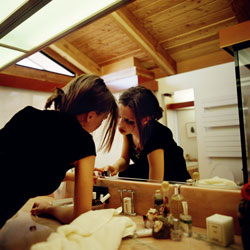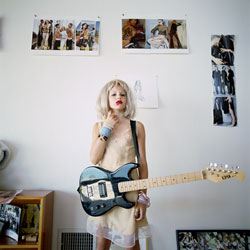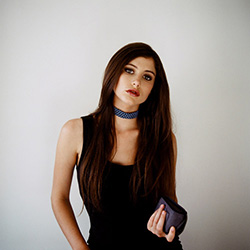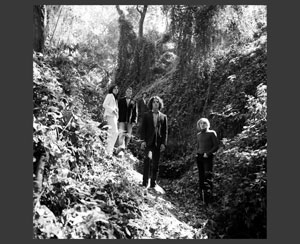
"Rock Star Moment 8"
Photo: Laura London (click to enlarge)
Copyright © Laura London 2000
|
Thirsty caught up with Laura London in Los Angeles where she has lived and worked for the last sixteen years. L.A., its youth culture and rock n’ roll have heavily influenced her work which Los Angeles Times critic Holly Myers has called “the most casual and naturalistic sense of looking in at private moments in the lives of today’s youth culture.” Her first solo show in Miami runs from January 10 to February 10, 2009 at the Daniel Azoulay Gallery in Miami, Florida and the works featured relate thematically to the ideas of personal identity, youth culture and rock n’ roll.
Thirsty: Your solo show in Miami this January features photographs from your "Rock Star Moment" series. This project has received much acclaim over the years. What drew you to this subject matter?
Laura London: Well, I was already working with the subject of youth culture and identity and I asked a young model who was the daughter of an artist friend of mine to pose for some images and I decided to incorporate the idea of the Rock Star. I wanted to concentrate specifically on the idea of the Rock Star and how the image of the Rock Star influences pre-teen and teenage adolescents. I did this by making a series focusing on this one girl and I had her dress up as these different Rock Stars and photographed her in the privacy of her bedroom using different locations such as the closet, the desk, the bedroom area, and the bathroom. I also showed before and after and process shots of the shoot. Each photograph has a narrative within the photograph, but they also function together as a narrative throughout the ten images that were included in the series. The Miami show is like a mini-retrospective and it includes the highlights from my last several bodies of work and four new pieces that relate thematically to the “Rock Star Moment” series.

"Rock Star Moment 2"
Photo: Laura London (click to enlarge)
Copyright © Laura London 2000
|
Thirsty: When you decided to do "Rock Star Moment," which Rock Stars influenced your thinking in this series and why?
LL: When I started doing this series, the model that I chose was very influenced by fashion and by MTV and the internet because she wasn't going out in the world yet. In addition, she was going to be Marilyn Manson for Halloween. So we sat down and discussed different Rock Stars. I guess I was looking for people with colorful personalities and people who had a story… someone such as Courtney Love who had an interesting story. She just reminds me of someone who’s reinvented herself a number of times and the same with Marilyn Manson. So the series was influenced by the Rock Star, but it was also influenced by the perception of the Rock Star. Just like their identity and personal style they show…the part of their identity they use to present their music and themselves to the world.
Thirsty: And is it the perception of the teenager’s version of the Rock Star or is it your perception of the Rock Star?
LL: It's my perception, but while I'm shooting if they do something that interests me, then I will incorporate that into the shoot. I mean the shots are completely constructed and set up. I would say that my photographs are conceptual as well as executed with formal concerns…fine art photography, but it's really about the idea. Music has been an influence of mine. I started doing photography and art as a teenager and then being around the teens as their teacher, I think it all just came together. Usually my series grow out of a previous body of work. The series before that was also based on youth culture and identity and then I added the rock n' roll element for the "Rock Star Moment” series. I think people are genuinely interested in seeing a private view into a teen's life and their fantasy world. So there's part the psychology of them creating their identity and then part the people seeing this private view of what goes into that and part the popular culture all mixed together.

Salon Style Wall 6, 2009
Portrait 3
Photo: Laura London (click to enlarge)
Copyright © Laura London
|
Thirsty: The New York Times has said that your work offered "nuanced approaches to the subject of female self-regard." To what extent are the images and settings you portray in your work autobiographical and yet representative of the human condition of young women?
LL: It is a combination of observations from being around these young women whom I teach photography and art. It is partially autobiographical and just what I'm observing culturally. So I think...all of my work has to do with identity: social, cultural and personal identity. It's just kind of talking about what I see. So there's some development in there...development issues from adolescence that people go through to try to fit in and be popular and trendy, and then some more psychological things I'm touching upon with the imagery and showing different moods or people trying different identities to fit in. I think it's also from attending and teaching in an art school environment and seeing how fashion and art influence each other. They usually have a fashion department in the schools that I've taught at and also just from observing rock n' roll…its influence on fashion as well. And then seeing young people…they seem to have the pulse of what's going on…just observing them go through their different trends. Trying to find themselves.
Thirsty: Were you identifying with moments in life when you were that age?
LL: Yes, some of the things are autobiographical. Technology is one thing that has really changed. It also really depends on the demographic and the location because in Los Angeles, teenagers are very influenced by the computer and previously by MTV because they're stuck without a car. Whereas if you grow up in New York or Chicago, you see more teenagers walking around. But the things that carry throughout different decades and different locations are more the personal identity and cultural identity. I guess I just saw...for the “Rock Star Moment” series that it was a pre-adolescent model and she seemed influenced by the media and what was going on because that was her world...as related to feminine issues and trying to establish her identity.
Thirsty: Your installation for the Photo Light Box Project of the L.A. County Metropolitan Transportation Authority (MTA) has gained great recognition. What was important to you about that project?

"Former Location/Contemporary Portrait"
Photo: Laura London (click to enlarge)
Copyright © Laura London 2005
|
LL: I was first awarded a permanent installation for the MTA for a new Metro line where I did a series called "Former Location / Contemporary Portrait”. I worked similar to a filmmaker and found locations where different events from rock n' roll history had taken place and then I recreated images inspired by those events. I took contemporary people, and did portraits...all of my work deals with portraiture…and then I used certain stylings that related back to the historic events. I interviewed a girl who had actually been at one of the concert locations, there was a Woodstock-type concert, and I established shots based on those scenes. The other one was inspired by an album cover from the back of a Rolling Stones album that was shot in the actual location. I tried to pick historic locations close to my Metro station because again I like the idea of the conceptual image. Then, I produced a series and used the two best images for the installation. I was awarded a grant to make two enamel panels 5’ x 5’ and then two 8’ x 27’ terrazzo ellipses. The photographs look photographic but they're made on photographic enamel steel panels, and the terrazzo ellipses are made from concrete mixed with granite and those were created from a detail of the photograph. I used a photo silkscreen technique to separate the tones and then made the designs for my ellipses to have a camouflage-type of look.
Then, the Photo Light Box commission came after that. It was a great honor to be awarded two public art projects. The Photo Light Box award was a three-year temporary public art commission for an already completed body of work. The Photo Light Box is a transparency that is backlit. There are seven 30” x 40” photo light boxes and they traveled throughout the Los Angeles area to different metro locations. They are up in one location for three to six months then they move to another location. They are up until the new year. It was a new venue for me and a way to present my work to a non-traditional audience…to do things outside the traditional gallery venue.
Thirsty: In the last five years, digital photography seems to have overtaken traditional film photography. How has the trend toward digital photography influenced your thinking as an artist?
LL: I guess I see it as another tool. I still use film as an artist working in the medium of photography, however, I've been making archival digital photographic prints for about ten years. That involves shooting film and having a high resolution, high quality drum scan made and then a light jet print. I work with a master printer to make these prints.

"Rock Star Moment 5"
Photo: Laura London (click to enlarge)
Copyright © Laura London 2000
|
Thirsty: Do your students believe there is a special romance to using film versus the ease of using digital?
LL: Yes, very much so. I actually am fortunate to be working in a program called “Summer of Art” at Otis College where there's an intensive college program for teenagers and young adults to get college credit in a one month's course. All of my students love film and they don't want to use digital. I think they like the hands-on. Everyone’s good at different things and certain people are good at using their hands. I guess with traditional photography you can see what you're doing. You can see the settings on the camera. It's very tactile, you're touching it, you see your results. Whereas digital, it's set up more like a computer...some people are very good at digital, but it's just set up completely differently…you have to do all the same settings on the camera and use light the same way you take a traditional photograph, but you can't see what you're doing on the outside of the camera. So I think the students want to make artwork by using the camera because it's more related to something like drawing or painting or sculpture. They want the hands-on experience. But I do like digital photography and I see it as a tool to incorporate into art-making. Digital is included as part of the curriculum and film is also included because it’s still very much part of being a fine art photographer.
Thirsty: How has the idea of collecting photography evolved over the last decade?
LL: After the post-modernist movement and the conceptual art movement, photography became much more accepted as a traditional art form. Even though people collected vintage, contemporary photographs, and documentary-style photographs, it seems like photography became more accepted and more available to people as an art form because those other art movements were using it in their art. Those artists, a lot of them were my instructors in graduate school at Cal Arts, were not trained classically in photography, but they used photography in their artwork and it just became more popular and more readily accepted. And, I think the idea of a small edition or special edition is very attractive in the way that printmaking is in terms of collecting a print as opposed to a painting. It makes it affordable to different types of collectors.
Links:
www.lauralondon.com
www.danielazoulaygallery.com |